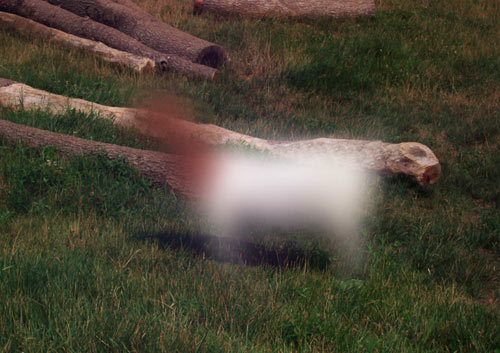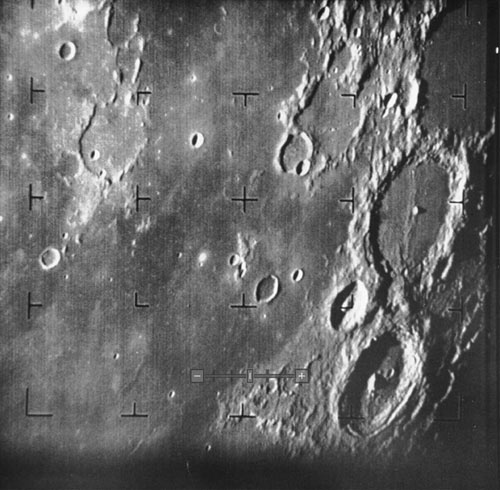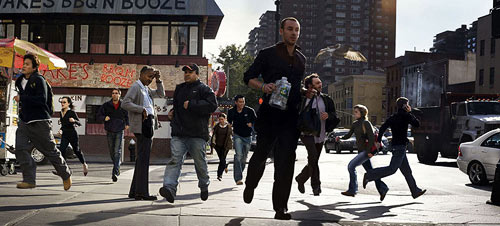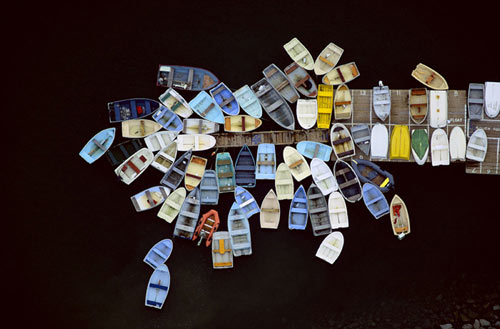kottke.org posts about photography
In praise of slow photography.
One advantage of using larger formats is that the process is slower. It takes time to set up the camera. It takes time to visualize what you want.
When doing portraits, it enables the photographer to talk and listen to subjects, to observe their behavior. A camera can trap a photographer sometimes. You can look so intently through a viewfinder that you are unaware of the picture in front of you. When I use an 8-by-10 camera for portraits, I will compose the picture and step back. Using a long cable release, I will look at the subject and wait for the moment. It’s very liberating.
A nice selection of “photos that changed the world”. Warning: some of them are NSFW and/or disturbing/upsetting. The first photo on the web was new to me.
Back in 1992, after their show at the CERN Hardronic Festival, my colleague Tim Berners-Lee asked me for a few scanned photos of “the CERN girls” to publish them on some sort of information system he had just invented, called the “World Wide Web”. I had only a vague idea of what that was, but I scanned some photos on my Mac and FTPed them to Tim’s now famous “info.cern.ch”. How was I to know that I was passing an historical milestone, as the one above was the first picture ever to be clicked on in a web browser!”
The NY Times kicks off their new photography blog with a video that shows just how short White House photo ops are.
When a photo-op is scheduled, the photographers, camera operators and reporters gather in the colonnade outside the Oval Office and wait — sometimes it can be as long as an hour — shuffling feet and making nervous small talk until the flutter of the fingers of the young staffer who calls, “Pool.”
Yesterday’s Pictures of the Day at the WSJ were particularly fine, including a US soldier in Afghanistan who didn’t have time to put on his uniform and gets caught by the camera taking up a defensive position in pink I [heart] NY boxers and flip flops.

Some days I feel just like a gaussian goat.

This is perhaps what the world would look like if human vision could perceive all of an object’s possible quantum mechanical states at the same time. (via today and tomorrow)
A photo of Rockefeller Center from 1933. The view is more or less looking west…that’s St. Patrick’s Cathedral in the foreground on the left.
Update: And here’s another shot of 30 Rock from 1933.
The Book Cover Archive Blog gets the skinny on using NASA images in creative work.
All of the media produced by NASA is public domain, meaning that anyone can use it any way (as long as they obey restrictions of publicity and privacy).
They also point to NASA Images, which is operated by Internet Archive and contains a copy of almost every image that NASA has ever produced. Just for the heck of it, here’s the first photo of the Moon taken by a US spacecraft.

In a post on his great blog, The Year in Pictures, James Danziger discusses some of the photography featured in a forthcoming book, The Final Four of Everything, including Danziger’s own selections for Iconic American Photographs. The Final Four of Everything seems to be a sequel of sorts to The Enlightened Bracketologist by the same authors…or perhaps just the same book with a much better title.
For the cover of Esquire’s June issue, photographer Greg Williams shot ten minutes of video footage of Megan Fox, from which the best stills were selected for the cover and inside the magazine.
As resolution rises & prices fall on video cameras and hard drive space, memory, and video editing capabilities increase on PCs, I suspect that in 5-10 years, photography will largely involve pointing video cameras at things and finding the best images in the editing phase. Professional photographers already take hundreds or thousands of shots during the course of a shoot like this, so it’s not such a huge shift for them. The photographer’s exact set of duties has always been malleable; the recent shift from film processing in the darkroom to the digital darkroom is only the most recent example.
Esquire’s moving cover reminds me of two other things.
1. Flickr encourages their members to think of short videos as long photos. When he guest edited kottke.org last year, Deron Bauman wrote about short video as a contemporary version of the photograph. Matt Jones argued that looping short video is the real long photography. So maybe the photograph of 10 years from now might not even be a still image.
2. In order to get the jaw-dropping slow-motion footage of great white sharks jumping out of the ocean, the filmmakers for Planet Earth used a high-speed camera with continuous buffering…that is, the camera only kept a few seconds of video at a time and dumped the rest. When the shark jumped, the cameraman would push a button to save the buffer.
There’s just too much good stuff on the internet today. So rather than flood the site with a bunch of posts, I’m going to clear out my tabs and round them up here.
Dear Prudence: “I cheated on my wife while sleepwalking. What do I do now?” I’ve heard quite a few weird/bad things about Ambien in the past few months. Also, paging Emily Gould from The Awl, please A this Q.
Rocketboom covers Single Serving Sites in their spin-off series, Know Your Meme.
The Big Picture peers into North Korea with a collection of photos of the dictatorship taken from neighboring China.
Maira Kalman visits Ruth Bader Ginsburg at the Supreme Court, illustrating the story beautifully as usual.
I return to the court to hear Justice Ginsburg speak to law students. And in answer to the question “How does it feel to be the only woman on the court?” she answers simply, “Lonely.”
The Society of Publication Designers has been busy posting nominees for their upcoming annual awards on their blog. Last year’s winners are here. (thx, david)
Jamie Zawinski has used his keyboard so much over the past eight years that he’s carved grooves into the M and N keys (with his fingernails?) and completely worn through part of his Alt key.
This was a tough series of photos to get through: The Bride Was Beautiful.
Katie Kirkpatrick, 21, held off cancer to celebrate the happiest day of her life. […] Her organs were shutting down but it would not stop her from marrying Nick Godwin, 23, who was in love with Katie since 11th grade.
The last photo is just heartbreaking. (via cup of jo)
Photographer Peter Funch spends weeks taking photos on Manhattan street corners and then pastes them together into single photographs.

I should add this (and Matt Webb’s 4D experiment) to my time merge media post. (via capn design)
Imagine Finding Me is a project by Chino Otsuka where she inserts her adult self into photos taken of her as a child. More examples at Wallpaper. See also Ze Frank’s Youngme / Nowme and those neat half-kid, half-adult photos that I can’t find a link to right now…little help? (via waxy)
Update: Age-maps! (thx, cindy)
Jim Griffioen took photos of every house on a block in Detroit where most of the houses are abandoned and stitched them into panoramas.
If you were to compare the current international housing crisis to a black hole sucking the equity out of our homes, this one-way street near the northern border of Detroit might just be the singularity: the point where the density of the problem defies anyone’s ability to comprehend it. These homes started emptying in 2006.
(via greg.org)
Harald Hauswald, an East German photographer, published in West Germany a book of his work in 1987. The East German secret police, the Stasi, put Hauswald under surveillance and even went so far as to produce a detailed critique of his book, as a photo critic might. Joerg Colberg recently met with the photographer and obtained a copy of the Stasi report on Hauswald’s work. From the report’s introduction:
Especially the selection of the images gives away that we are dealing with a book that has a long-term purpose. People gathered everything somber, oppressive, from poor neighbourhoods, or primitive they could find. It seems apparent that color was intentionally omitted, because only black and white reproduction stresses the supposedly gray, bleak and dismal reality of East Berlin.
It’s interesting to hear the charge of propaganda coming from the secret police of a Communist dictatorship.
If the naked eye could see like a telescope, this is what the night sky might look like. (via rw)
From a series of posts on how not to photograph (for serious/professional photographers, I would presume): playing possum, the zig zag, and the vacation slide show. I am glad I’m not a serious photographer. (via conscientious)
Hello photographers! I just ran across this photo (via TrueHoop) and was wondering if anyone out there knows how it was made. My guess is a combination of an IR camera, IR spotlight, and a bit of digital darkroom colorization after the fact. How else would you get lighting like that during an actual game? Anyone?
Update: Thanks, gang. Looks like a remotely fired strobe light is the culprit. No IR shenanigans needed.
20x200 has a print by Mark Richards of an exploded Apple I machine.
In the photographs, a visual parallel between the wires delivering energy to a mechanical memory and the neural pathways of human anatomy becomes apparent. The pieces of machines are re-framed as something more than cold technology; I hope I can provide emotion, unexpected beauty and history.
(via df)
Errol Morris returns to his NY Times blog with a five-part story about a photograph found in the hands of an unknown Union army soldier who died at Gettysburg. Start with part one. A description of the photograph made it into the newspaper and the identity of the man was pretty quickly discovered. But the story hardly ends there. My favorite part so far is the fourth, particularly the conversation between Morris and one of the unknown soldier’s descendants, archaeologist David Kelley.
A photo gallery that shows how marshmallow Peeps are made inside the Just Born confection company in Bethlehem, Pennsylvania.
Seeing a shower-capped woman dye-coat sugar with an industrial-grade sprayer puts a supreme damper on my sugar high.
Peculiar little video by Keith Loutit for a song called “Clementine.” Utilizes tilt-shift photography to achieve its miniature look.
via Nothing for X
The ruins of Detroit, a series of photos by Yves Marchand & Romain Meffre documenting vacant buildings in Detroit. Some of the photos are repeated with useful annotation in this Time photo gallery. (See also Brian Ulrich’s Stores That Are No More.)
On the other hand, some are arguing that there is great opportunity in Detroit right now.
Detroit right now is just this vast, enormous canvas where anything imaginable can be accomplished.
Newer posts
Older posts










Stay Connected